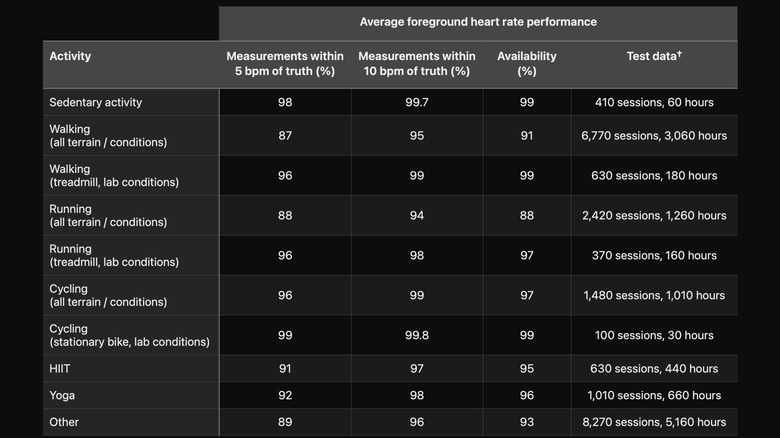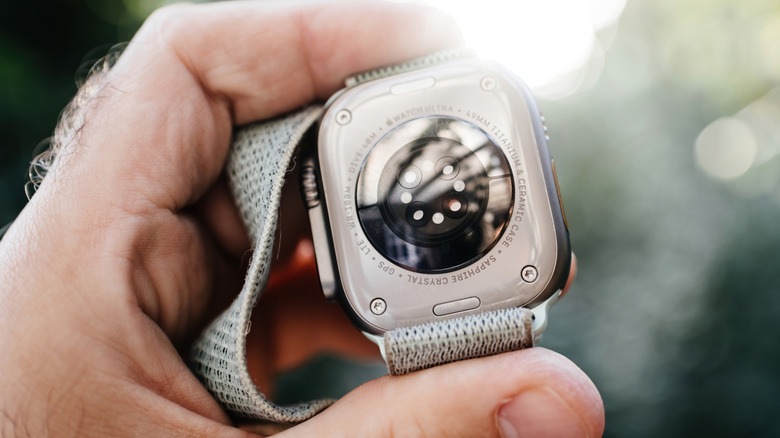Just How Accurate Is The Heart Rate Monitor In The Apple Watch?
When the first Apple Watch made its global debut, Apple said it was a product that would enrich people's lives and encourage them to adopt a healthier lifestyle, thanks in part to a heart rate sensor built into the device for accurate heart rate measurement. Over time, the company refined the hardware and software stack to include tools like AFib sensing and abnormal heart activity patterns that could be a sign of heart failure. But how accurate is the heart rate sensor on the Apple Watch? In a nutshell, it's pretty reliable, whether you are using it for keeping an eye on heart activity during daily routines or various kinds of workouts.
The optical heart rate sensor on the smartwatch is a composite unit that includes light-sensitive photodiodes, alongside infrared and green LEDs. The sensor relies on a proxy technique called photoplethysmography (PPG), which measures heart rate based on the amount of blood flowing through the vessels and the changing pattern of light absorption. Before we dig into the details, it's worth pointing out that the Apple Watch's heart rate sensor is not a medical device.
It's not as accurate as the medical-grade devices that collect heart rate readings. Moreover, Apple's wearable relies on sensor fusion and heart machine learning (ML) algorithms to continuously monitor heart rate activity. These algorithms also allow the sensor to enable heart-related features such as resting and moving heart rate average, cardio recovery, high and low heart rate, and irregular rhythm notifications, AFib history, and cardio fitness, among others.
Accuracy is not an absolute metric
The Apple Watch's sensor relies on the infrared LEDs to measure resting and day-to-day heart activity, and shines the green LEDs when users are working out. That's because the heart rate varies during these phases, and more importantly, the accuracy also varies. According to Apple's internal health study that was published in November 2024 and collected data from thousands of activity sessions, the sensor is accurate to within 5 bpm (beats per minute) for 98% of the time when users are in sedentary (or resting) mode, and reaches 99.7% accuracy with an error margin of 10bpm.
The sensor's heart rate accuracy falls to 96% for outdoor cycling, 87% while walking, 88% while running, and 91% during high-intensity workouts, all with an error margin of 5 beats per minute when the data is recorded in the foreground. It's worth noting that starting with the Apple Watch Series 6 and subsequent models, the sensor's accuracy has increased significantly. Based on data collected from 480 participants logging 21,000 hours of activity, the sensor's background (passive monitoring) heart rate accuracy is 89% (within a 5 bpm error margin), while the Apple Watch Series 5 and older models achieve only 72% accuracy at background heart rate activity monitoring.
When the error margin is relaxed to 10 bpm, the accuracy of newer Apple Watch models shoots up to 97%, while older models can only manage 85% accuracy in background heart rate measurement. Moreover, the sensor assembly also added red LEDs for measuring blood oxygen saturation levels on the Apple Watch Series 6 and later models. However, it's unclear whether the red lights have helped improve the sensor's accuracy.
Independent validation of Apple Watch sensor accuracy
The results from independent testing of the Apple Watch also show impressive accuracy results, especially from a comparative perspective in the wearable segment. A meta-analysis of 56 studies that tested the Apple smartwatch found a mean bias of -0.12 (negative) beats per minute, which is deemed "within acceptable limits," though it adds that the Apple Watch "may underestimate HR." Another test-based paper published in the Journal of Student Research measured the Apple Watch against a chest-strapped electrical heart rate sensor from Polar while athletes ran on an ergometer. The team found a deviation ranging from 0.333 to 1.333 beats, concluding that the variations are not statistically significant.
"The heart rates became less accurate as stages intensified for the Apple Watch but showed no true statistical difference," says the paper. A peer-reviewed study that tested the Apple Watch among patients (chronic conditions such as hypertension and diabetes) found a strong correlation between the Apple Watch and the gold-standard Polar chest strap. It notes that the Apple Watch provides satisfactory results that "support the concept of increasing its use in clinical practice settings" for measuring heart rate, even among people at risk of cardiovascular ailments.
These findings, however, are not applicable universally. A paper published in the IEEE Journal of Translational Engineering in Health and Medicine cautions that individuals with cardiac arrhythmias, such as atrial fibrillation (AFib), should exercise caution when using the Apple Watch for heart rate monitoring. Overall, the conclusion is that the Apple Watch is fairly accurate for passive heart rate and mid-workout heart rate monitoring, but should not be used as a substitute for medical-grade HR monitors, especially if a person is living with heart conditions.


